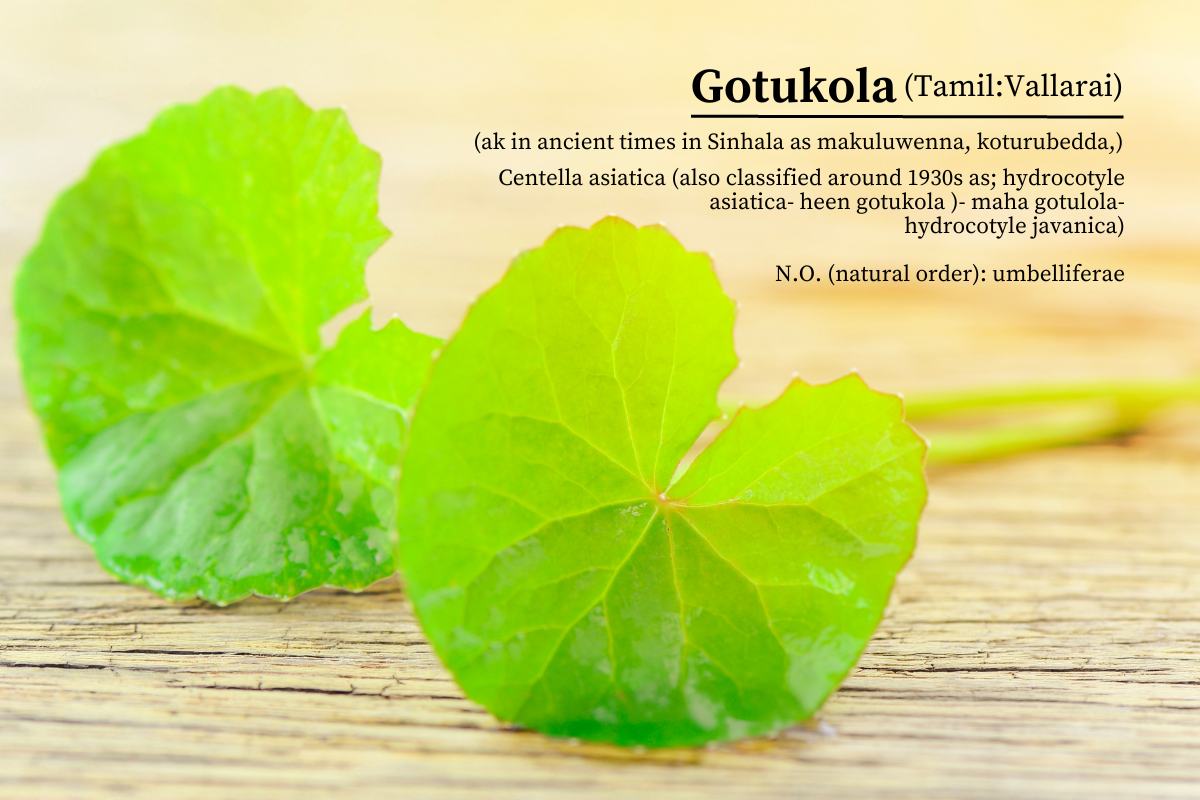

A perennial herb, creeping plant with long prostrate stems given off from the leafaxils of a short
root stock and shiny leaves broader than long 1 1⁄2- 2 inches, umbels of small nearly sessile dark pink flowers and
small ovoid fruits with a thickened pericarp, propagates by producing stolons. Leaves are aromatic taste.
One of the 3700 species in the parsley, carrot, coriander and cumin family including some phototoxic species
(such as asafoetida – perumkaya) that have medicinal potential.
The whole plant can be used for nutritive as well as medicinal purposes. It is a good source of dietary fiber and
vitamins B and C and minerals iron and calcium. High levels of triterpenoids present in gotu kola stimulate type
I collagen formation, which is the most abundant collagen found in connective tissues including skin, tendon,
and bone tissue. Its dermatological benefits can be used for medicinal as well as cosmetology purposes. It
inhibits the progression of cellulite. It is also known to increase the length of telomeres and as such holds
promise in preventative and anti-ageing medicine. It is astringent and antiseptic. Inflammation of oral mucosa as
in stomatitis presented by painful oral ulcers resulting in difficulty in drinking and eating can be treated with
gotu kola in the form of a gargle/mouth wash. Gotu kola sautéed in ghee (elengi thel) has been traditionally used
to treat chapped and splitting lips. Internally it acts as an aromatic stomachic and carminative and as such has its
uses in anorexia and acute as well as chronic dyspepsia/indigestion. It is known to easily absord heavy metals or
toxins in the soil and water in which it is grown.
Gotu Kola has been used extensively in Chinese medicine. In Ayurveda it is classified as a leafy vegetable with
medicinal properties laghu (light)-increase vata and decrease kapha, sara (sara guna unstable, fluid, mobility,
quality, as such could reduce stiffness see connection to collagen formation), astringent and sweet in taste, cold
in potency, said to enhance mental faculty (medhya), improves memory, overall subdues all three doshas. Said to
improve memory and understanding given in combination with kumbum dalu(tender leaves of caeseapina
bonucela) and ginger to children with deranged bowels and vomiting arising from intestinal worms, used also for
fever and hoarseness given with milk after mixing with vadakaha (acorus calamus), long pepper, rock salt and
liquorice root. Useful in skin lesions, wound healing, venous insufficency, varicose veins, hypertension,
insomnia, acts as a brain tonic.
The phytochemistry and neurological effects
Phytochemicals identified from C. asiatica to date include isoprenoids (sesquiterpenes, plant sterols, pentacyclic
triterpenoids and saponins) and phenylpropanoid derivatives (eugenol derivatives, caffeoylquinic acids, and
flavonoids). Contemporary methods for fingerprinting and characterization of compounds in C. asiatica extracts
include liquid chromatography and/or ion mobility spectrometry in conjunction with high-resolution mass
spectrometry. Multiple studies in rodent models, and a limited number of human studies support C. asiatica’s
traditional reputation as a cognitive enhancer, as well as its anxiolytic and anticonvulsant effects.
Neuroprotective effects of C.asiatica are seen in several in vitro models, for example against beta amyloid
toxicity, and appear to be associated with increased mitochondrial activity, improved antioxidant status, and/or
inhibition of the pro-inflammatory enzyme, phospholipase A2. Neurotropic effects of C. asiatica include
increased dendritic arborization and synaptogenesis, and may be due to modulations of signal transduction
pathways such as ERK1/2 and Akt. Many of these neurotropic and neuroprotective properties of C.asiatica have
been associated with the triterpene compounds asiatic acid, asiaticoside and madecassoside. More recently,
caffeoylquinic acids are emerging as a second important group of active compounds in C. asiatica, with the
potential of enhancing the Nrf2-antioxidant response pathway.
Macronutrients found in Centella asiatica (C. asiatica) are mainly proteins, carbohydrates, and
fibers. The amino acid profile of C. asiatica showed ten essential amino acids including histidine
and arginine and eight non-essential amino acids. The highest essential amino acid found was
histidine followed by lysine, Isoleucine and phenylalanine; while glutamate and aspartate were
recorded as highest in the nonessential amino acids category. Furthermore, C. asiatica contains
moisture, and minerals such as phosphorus, iron, sodium, calcium and potassium. In addition to
that, C. asiatica is rich in vitamin C, B1, B2, niacin, carotene, and vitamin A. The amount of
macro and micronutrients are shown in table 1, 2, 3 & 4. It should be highlighted that C. asiatica
is a good source of dietary fibers and contains a high concentration of potassium and calcium.
These values may considerably vary depending on the analytical method and biotic and abiotic
factors.